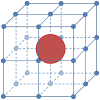Computational modeling of 3D tumor growth and angiogenesis for chemotherapy evaluation
- PMID: 24404145
- PMCID: PMC3880288
- DOI: 10.1371/journal.pone.0083962
Computational modeling of 3D tumor growth and angiogenesis for chemotherapy evaluation
Abstract
Solid tumors develop abnormally at spatial and temporal scales, giving rise to biophysical barriers that impact anti-tumor chemotherapy. This may increase the expenditure and time for conventional drug pharmacokinetic and pharmacodynamic studies. In order to facilitate drug discovery, we propose a mathematical model that couples three-dimensional tumor growth and angiogenesis to simulate tumor progression for chemotherapy evaluation. This application-oriented model incorporates complex dynamical processes including cell- and vascular-mediated interstitial pressure, mass transport, angiogenesis, cell proliferation, and vessel maturation to model tumor progression through multiple stages including tumor initiation, avascular growth, and transition from avascular to vascular growth. Compared to pure mechanistic models, the proposed empirical methods are not only easy to conduct but can provide realistic predictions and calculations. A series of computational simulations were conducted to demonstrate the advantages of the proposed comprehensive model. The computational simulation results suggest that solid tumor geometry is related to the interstitial pressure, such that tumors with high interstitial pressure are more likely to develop dendritic structures than those with low interstitial pressure.
Conflict of interest statement
Figures










Similar articles
-
The effect of interstitial pressure on therapeutic agent transport: coupling with the tumor blood and lymphatic vascular systems.J Theor Biol. 2014 Aug 21;355:194-207. doi: 10.1016/j.jtbi.2014.04.012. Epub 2014 Apr 19. J Theor Biol. 2014. PMID: 24751927 Free PMC article.
-
The pivotal role of angiogenesis in a multi-scale modeling of tumor growth exhibiting the avascular and vascular phases.Microvasc Res. 2018 Sep;119:105-116. doi: 10.1016/j.mvr.2018.05.001. Epub 2018 May 6. Microvasc Res. 2018. PMID: 29742454
-
Quantifying the effects of antiangiogenic and chemotherapy drug combinations on drug delivery and treatment efficacy.PLoS Comput Biol. 2017 Sep 18;13(9):e1005724. doi: 10.1371/journal.pcbi.1005724. eCollection 2017 Sep. PLoS Comput Biol. 2017. PMID: 28922358 Free PMC article.
-
The Solid Mechanics of Cancer and Strategies for Improved Therapy.J Biomech Eng. 2017 Feb 1;139(2):10.1115/1.4034991. doi: 10.1115/1.4034991. J Biomech Eng. 2017. PMID: 27760260 Free PMC article. Review.
-
Computer Simulations of the Tumor Vasculature: Applications to Interstitial Fluid Flow, Drug Delivery, and Oxygen Supply.Adv Exp Med Biol. 2016;936:31-72. doi: 10.1007/978-3-319-42023-3_3. Adv Exp Med Biol. 2016. PMID: 27739042 Review.
Cited by
-
Precision Medicine with Imprecise Therapy: Computational Modeling for Chemotherapy in Breast Cancer.Transl Oncol. 2018 Jun;11(3):732-742. doi: 10.1016/j.tranon.2018.03.009. Epub 2018 Apr 16. Transl Oncol. 2018. PMID: 29674173 Free PMC article. Review.
-
Multiscale Modeling in the Clinic: Drug Design and Development.Ann Biomed Eng. 2016 Sep;44(9):2591-610. doi: 10.1007/s10439-016-1563-0. Epub 2016 Feb 17. Ann Biomed Eng. 2016. PMID: 26885640 Free PMC article. Review.
-
A multiscale model of complex endothelial cell dynamics in early angiogenesis.PLoS Comput Biol. 2021 Jan 7;17(1):e1008055. doi: 10.1371/journal.pcbi.1008055. eCollection 2021 Jan. PLoS Comput Biol. 2021. PMID: 33411727 Free PMC article.
-
AMBER: A Modular Model for Tumor Growth, Vasculature and Radiation Response.Bull Math Biol. 2024 Oct 26;86(12):139. doi: 10.1007/s11538-024-01371-4. Bull Math Biol. 2024. PMID: 39460828
-
Examining the efficacy of localised gemcitabine therapy for the treatment of pancreatic cancer using a hybrid agent-based model.PLoS Comput Biol. 2023 Jan 17;19(1):e1010104. doi: 10.1371/journal.pcbi.1010104. eCollection 2023 Jan. PLoS Comput Biol. 2023. PMID: 36649330 Free PMC article.
References
-
- Endrich B, Reinhold H, Gross J, Intaglietta M (1979) Tissue perfusion inhomogeneity during early tumor growth in rats. J Natl Cancer Inst 62: 387–395. - PubMed
-
- Carmeliet P, Jain R (2011) Principles and mechanisms of vessel normalization for cancer and other angiogenic diseases. Nat Rev Drug Discov 10: 417–427. - PubMed
-
- Araujo R, McElwain D (2004) A history of the study of solid tumour growth: the contribution of mathematical modelling. Bull Math Biol 66: 1039–1091. - PubMed
Publication types
MeSH terms
Substances
Grants and funding
- 1U54CA143907/CA/NCI NIH HHS/United States
- U54 CA143907/CA/NCI NIH HHS/United States
- 1U54CA151668/CA/NCI NIH HHS/United States
- U54 CA151668/CA/NCI NIH HHS/United States
- U54 CA143837/CA/NCI NIH HHS/United States
- R01 EB009009/EB/NIBIB NIH HHS/United States
- U01CA166886-01/CA/NCI NIH HHS/United States
- U54 CA149196/CA/NCI NIH HHS/United States
- 5R01EB009009-06/EB/NIBIB NIH HHS/United States
- 1U54CA143837/CA/NCI NIH HHS/United States
- U01 CA166886/CA/NCI NIH HHS/United States
- 1U54CA149196/CA/NCI NIH HHS/United States
LinkOut - more resources
Full Text Sources
Other Literature Sources

